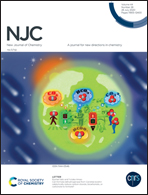Crystal structures of N6-modified-amino acid nucleobase analogs(iii): adenine–valeric acid, adenine–hexanoic acid and adenine–gabapentine†
Abstract
In this manuscript we report the synthesis and structural characterization of three amino acid adenine derivatives: N-(7H-purin-6-yl)-5-aminovaleric (N6-5AValAde) (1), N-(7H-purin-6-yl)-6-aminohexanoic (N6-6AHexAde) (2) and N-(7H-purin-6-yl)gabapentine (N6-GabapenAde) (4); and the hydrochloride form of 2, (3). In compound (1) with a neutral adenine ring and the chain arranged almost in an orthogonal position, the carboxylic groups interact with the N(7) and N(6)–H(6) of the neighbour molecule forming 1D supramolecular polymers. It also establishes strong N(9)–H⋯N(3) interactions between the adenine rings leading to self-assembled dimers. In the layered compound (2), the adenine also forms self-assembled dimers via double N(9)–H⋯N(3) interactions. However, conversely to (1), the chain is arranged in the same plane of the ring facilitating the formation of coplanar self-assembled dimers via the Hoogsteen face. In the hydrochloride form of N6-6AHexAde (compound 3) the adenine ring is protonated in N(1) which is hydrogen bonded to the chloride anion [N(1)–H⋯Cl = 2.198 Å]. As with the neutral compound (1), the carboxylic group is bound to N(7) and the H–N(6) of a neighbour molecule and the double and strong [N(9)–H⋯N(3) = 2.069 Å] interaction between coplanar adenine rings is present. A common feature of compounds (1)–(3) (linear amino acid), is the formation of adenine⋯carboxylic group interactions via the de Hoogsteen site of adenine, and also adenine⋯adenine self-association via N(9)–H⋯N(3) interactions. In compound (4), that incorporates a gabapentine chain attached to the adenine ring, 3D packing is organized again with protonated carboxylate and N(7)/H–N(6) contacts: [O(19)–H⋯N(7) and O(18)⋯HN(6)] and a water molecule that holds 3 different molecules together by forming three O/N⋯H hydrogen bonds. Again stacking interactions between the eclipsed pyrimidine rings in anti disposition [C(5)⋯C(2)/C(2)⋯C(5) of 3.387 Å] are observed. Finally, we studied the noncovalent interactions observed in the solid state architecture using DFT calculations, and rationalized the interactions using molecular electrostatic potential surfaces and the quantum theory of “atoms-in-molecules”. The aim of this study is to investigate the competition between homodimer formation by the Hoogsteen face of the adenine/adeninium, self-association of the carboxylic group, or the interaction of the carboxylic group with the adenine/adeninium cation.



 Please wait while we load your content...
Please wait while we load your content...